Mines, Depleted Uranium, and Important Addendums
Not quite a SITREP, but some updates on important topics in the battlespace.
I wanted to follow up with a little explanatory piece about two currently crucial issues faced by the Russian side in the war.
Firstly, there’s the topic of DU—depleted uranium. Britain has announced that it will be supplying DU penetrator rods along with its Challenger-2 tanks. As you know, with my analysis, I always strive to uncover the small unspoken things under the hood, the angles that the more ‘mainstream’ narratives fail to see, acknowledge, or understand.
First, a very brief summary of what DU rods are. It’s very simple: tank armor is mostly made of steel. If you shoot an ammo APFSDS (Armor Penetrating Fin Stabilized Discarding Sabot) round that is also made out of steel, then you’re basically hitting the enemy tank with a round made of the same density/hardness, which, by way of the eternal Newtonian Laws, would cause the steel round to mushroom and break apart, for the most part, from the much sturdier opposing force of the tank armor.
So militaries began to use Tungsten rounds. Tungsten is much harder/denser than steel, in fact it’s even denser than pure Uranium. However, Tungsten is much more rare and expensive. Depleted Uranium has similar hardness though but is cheaper because it’s literally made from radioactive waste / byproduct from nuclear power plants, which they no longer need. It’s of course mostly denuded of its radioactivity, but a small amount remains.
So Tungsten or Uranium hitting steel armor is a far denser force going against something like a knife through butter. In reality, it’s much more complicated and detail-intensive, as Tungsten in some ways is even superior to DU, but it is much more expensive.
A table like the one below shows that WHA (90% Tungsten alloy) actually penetrates better than DU with certain variables and velocities in place. But the bottom line to understand is that DU penetrates far better than regular steel-tipped rounds, and is much cheaper to make than Tungsten.
British defense ministry has issued a statement, citing ‘independent research from scientists’, that any adverse health effects from DU are minimal: Video.
It’s difficult to fully verify, particularly due to the fact that its so greatly in the U.S. and West’s interests to sweep under the rug and memory hole such research, but the numbers floating around the internet are along these lines:
Study Fallujah, #Iraq 2005 - 2010:
▪️Leukemia increased 38x,
▪️Brain tumors 13x
▪️Lymphoma 10x
▪️Cancer in children 10.5x
This is corroborated by articles from a long time ago, perhaps when it was a little easier to publish ‘inconvenient’ facts, before Big Tech completely fettered the internet with their barbaric ‘WrongThink’ cleansing algorithms. This Guardian article from 2009 for instance, confirms a 15x increase in birth defects in infants.
But there are two ways to think about this. The first is that, the Battles of Fallujah, which are the primary culprits where this DU poisoning took place, were maybe two months long in total, combined. That means, we can consider the fact that in only two months of firing DU in Fallujah, they poisoned the population to such a degree as to affect upwards of 14% of births with defects.
Many or most of us agree that the Ukrainian war will drag on perhaps for several years. So imagine what type of contamination would result from a period of DU usage that is 10x or 20x longer than the Fallujah battles which scoured and poisoned the landscape?
The only check we can put on that thought, is the argument that perhaps the US/UK fired such a vast volume of DU in that short time, owing to the fact that they used far more DU-capable armor, that it would still constitute a greater total DU usage than all of Ukraine could accumulate even over the course of two of three years of fighting. We must remember that the coalition’s DU usage was not limited merely to MBT (Main Battle Tanks) but several other systems, including A-10 Warthogs spraying 30mm DU rounds at ungodly RPM’s into everything in the landscape.
So this argument will hinge on how many total DU-capable systems Ukraine will receive. For now, as I understand it, only the UK with their Challenger tanks has openly offered DU rounds, and currently the pledged supply of those tanks is low.
However, given the far greater intensity of this conflict compared to Iraq, we also know that tanks on the frontline fire exponentially more rounds in general, than any other recent conflict. So there is merit in assuming that perhaps the total accumulation of DU round usage in Ukraine over the course of two, or three, or even more years, could still equal or greatly surpass the usage in the Iraq war. Particularly if 1.) the UK eventually pledges/delivers more Challengers and 2.) if the US and/or other countries likewise join the call and supply DU rounds to the tanks they’re delivering.
On the second point, there was this unconfirmed report/RUMINT:
At the same time, it turns out that the upcoming British delivery will be only a pilot project before the mass deliveries of American 120-mm M829A1 and M829A2 shells, also with a depleted uranium core.
So in short, it is plausible that the Donbass region could face massive contamination, perhaps even eclipsing that of the Chernobyl exclusion zone. And guess what? The AFU commanders would gleefully and gladly help effect such a scenario; they would view irradiating the Donbass, and making the land there uninhabitable, as a delicious ‘just desserts’ against Russia for having ‘taken it’ from them.
As a corollary, one source stated that the US has used 300 tons of depleted Uranium in Iraq. Given that US DOD’s official numbers show that 0.3% of DU is active U, we can do the following basic math. 300 tons converted to pounds is = 660,000lbs. And 0.30% of 660k lbs is 1,980lbs. That means the US dumped almost a full ton (~2000lbs) equivalent of full-on radioactive Uranium on Iraq.
According to the Iraqi government, in 2005 the cancer incidence in the country because of the use of depleted uranium rose from 40 to 1,600 cases per 100,000 people. There has also been a 25% increase in cancer incidence in the countries of the former Yugoslavia.
After the use of depleted uranium shells, large areas of crops on Ukrainian territory will be contaminated, and radioactive substances will be spread through vehicles to the rest of the territory. This would cause enormous economic damage to Ukraine’s agro-industrial complex, bringing down any export of agricultural products from Ukraine.
However, the bigger issue in Uranium is not its radioactivity per se, but rather its ‘chemical toxicity’. It is heavily toxic to the environment, like other ‘heavy metals’ such as mercury, lead, etc., and carcinogenic due to the way its molecules displace vital nutrients in our organs, lymph nodes, etc., causing breakdowns in DNA structure, amongst other things.
And to compound this, Iraq was mostly desert while Ukraine is full of farm fields which will be cultivated, and the food grown there eaten by millions of people which will greatly spread the toxicity and exponentially compound the amount of potential damage to the population.
Several Russian politicians, for their part, have reacted with statements:
Some, like the above, have issued strong threats, while others, like Shoigu at the 0:55 mark of this video, were more mysteriously reserved and diplomatic. For those that can’t access the video, Shoigu demurely replied: “Well, this moves us to serious thoughts about the further course of events and what we can answer.”
Russia to deploy tactical nuclear weapons in Belarus
The governments of the two countries have agreed to place tactical nuclear weapons on the territory of Belarus, Vladimir Putin said in an interview with the Rossiya 24 TV channel.
According to the President, the construction of a storage facility for tactical nuclear weapons will be completed on July 1.
He also noted that such actions do not violate obligations under the START.
The reason for this step was the decision of the UK to supply Ukraine with ammunition with depleted uranium.
In a slightly strange answer, Putin stated that Russia itself has hundreds of thousands of DU shells and can use them in retaliation. This strikes an obvious strange tone, as why would Putin want to poison his own (soon to be) country with DU? The only answer is if the military feels it absolutely necessary from the standpoint of going up against the new Abrams/Leopards/Challengers. They may feel that in order for Russian tankers to stand a chance in penetrating these advanced western tanks, they too will have to utilize DU rounds to even the playing field.
If such a thing were to happen, it only supports my previous presupposition that several years worth of such back and forth DU slinging could catastrophically poison the land even worse than a few mere months of intense DU usage in Iraq.
**
Onto the next subject.
One addendum I wanted to make on the last writeup, apropos the issue of Polish re-armament and slow-march towards war. I forgot to include the recent statement, which has generated much buzz and controversy, from the Polish ambassador to France who, on a French television show, stated that if Ukraine loses, Poland will have to ‘enter the war’.
The Polish government even had to issue a retraction, calling it a misunderstanding.
This is just another small facet in the ever-growing chorus of beating war drums from Poland.
**
Now, in this segment I want to cover a few technical things that I’ve been meaning to cover, in order to help explain some of the situations on the front that have left some people puzzled.
The first of which is the mine situation. Particularly in regard to Ugledar, where we witnessed some nasty videos of Russian tank scouts from the 5th Tank Brigade and infantry of 37th Motorized Rifle Brigade of the 36th Combined Arms Army (Eastern Military District), as well as the 155th Pacific Fleet Naval Marines get decimated by mines in a couple of outings.
Many were understandably shocked and puzzled at how this could happen, and why Russia can’t properly clear the mines. Firstly I posted photos like this one, showing the sheer density of TM-62 mine saturation that the AFU carries out in these approach fields:
But the primary thing to understand, is that the AFU uses a combination of older Soviet TM-62 mines laid along side with western magnetic mines. The problem is, Russian tank mine trawls do not set off the magnetic mines. This recent Forbes article explains it.
The problem is that the KMT mine-rollers only work on pressure-triggered mines such as the Soviet-vintage TM-62. But modern Western mines have multiple trigger options, including magnetic proximity.
A minefield with magnetically-triggered American-made Remote Anti-Armor Mines—scattered by 155-millimeter artillery shells—pretty much is immune to a KMT mine-roller. A Russian tank could roll up and dig up the RAAMs with its KMT-5 or KMT-7 and still trigger the mines.
Worse for the Russians, the Ukrainians tend to mix mine types. Bury some TM-62s then scatter RAAMs on top. These mixed minefields have halted Russian assaults near Vuhledar, in eastern Ukraine’s Donbas region 60 miles south of Bakhmut.
A video that a Russian T-72 tank crew shot late last year, apparently in Donbas, illustrates the Russians’ dilemma. In the video, the T-72 triggers a pressure mine with its KMT-7, safely blowing up the mine ahead of the tank. But a few seconds later, a second mine—maybe a magnetic one—strikes the tank.
So, to unpack this. The Ukrainians scatter instant minefields by way of RAAMS, which is Remote Anti-Armor Mine System. This is basically an 155mm artillery shell which can be fired from any of the Western systems delivered to Ukraine. The shell explodes over the targeted territory and scatters electromagnetic mines all over the vicinity. The US is said to have delivered over 10,200 of such shells (each of which holds many mines).
This Forbes article specifically goes into the RAAMs system in use by Ukraine. The article outlines a tactic the Ukrainians use, which was actually confirmed by a separate Russian military source in an angry Telegram post. The tactic goes as follows:
There are indications the Ukrainians have adopted a clever new method of laying mines. Ukrainian gunners wait until Russian troops clear a path through an old minefield—then toss fresh mines onto that same path right as the Russians are crossing.
This tactic appears to be on display around Vuhledar—a town with a pre-war population of just 14,000 that lies a couple of miles north of Russian-held Pavlivka, 25 miles southwest of Donetsk in eastern Ukraine’s Donbas region.
So, first they lay the older Soviet TM-62 mines and let Russian mine sweepers successfully clear a path through them, but then, right before the actual assault can come through the path cleared by the minesweeper with a tank trawl, the UA troops shoot these RAAMs projectiles to lay the much more numerous ‘smart mines’ all over the path.
American experts like the infamous ‘Trent Telenko’ are in raptures over Russia’s inability to combat these compared to the mighty ‘American Way’:


But what is America’s much more advanced method of clearing such mines? Enter the FWMP - Full Width Mine Plough. In short, it’s basically a snow plow that gouges up the earth and pushes it to the sides of the tank. This merely ‘pushes the magnetic mines’ away towards the side of the path, and in no way disables them. You be the judge how effective that would be in real combat situations.
I can name a few problems off the top of my head. Firstly, how would it deal with the different types of terrain, such as frozen ground where the ploughs would be nearly useless in tearing up the earth in such a way? It seems to me it would only work in ideal soft ground conditions, and even then it’s still only pushing the mines to the side and creating a narrow path which itself creates a targetable kill zone. How, for instance, would the Americans deal with the same tactic so exultantly outlined by Forbes? If it was the U.S. up against the AFU, and the AFU simply continually showered the path with RAAMs mines, it makes such sweeping moot.
Also, the triumphant gloating from the Forbes article and elsewhere, that ‘backwards Russia’ has no capabilities to deal with this is off-base. They continually point to the more antiquated, regular mine trawls like the KMT-7, but they ignore that Russia has newer systems like the TMT-K which is specifically designed to deal with electromagnetic mines.
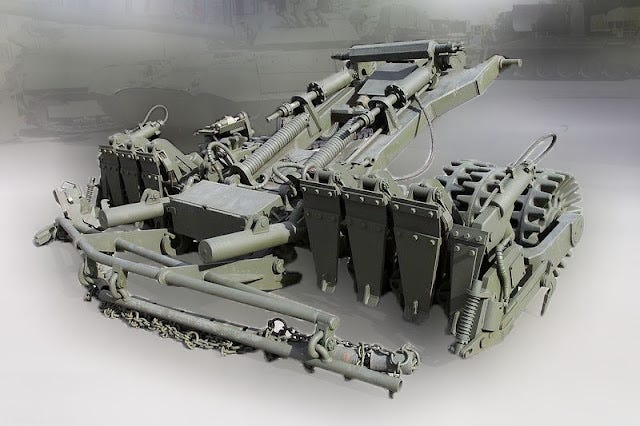
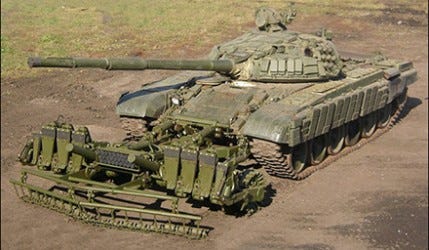
In fact, the TMT-K is likely the most advanced such mine trawl in the world, and the U.S. has nothing of the like in its inventory.
“This trawl consists of a roller array with pressure action and soil cutters, a device for trawling anti-side mines and an electromagnetic module. The trawl also includes electrical equipment, a pneumatic system, a pyro signal cassette and a single spare parts kit.
The TMT-K mine trawl provides trawling capabilities against most anti-tank mines: anti-burr mines, anti-bottom mines with contact and non-contact magnetic fuses, anti-slide mines with non-contact seismic-optical fuses, as well as the destruction of wired control lines for mine explosions, land mines and triggering remote installation mines installed on the ground surface.”
The problem is, it’s a relatively recent addition, only introduced in the last few years and so it’s not widespread yet compared to the older KMT-7 style mine trawls.
In fact, one T-90M tank with the TMT-K was already seen in theater, possibly disabled, although it’s uncertain whether from a mine or something else:

In fact Russia has a host of newer, advanced mine sweeping vehicles, including a vehicle that kills mines electromagnetically, i.e. “zapping” or “frying” their electronics, called the Listva Remote Demining Vehicle:
As well as the new BRM-3M minesweeper tank based on the T-90M which includes magnetic rollers that are meant specifically to be able to set off such magnetic mines.
But as with everything, the biggest problem in the Russian army is one of availability. Thus, many troops still have to use the older varieties.
Also, the other important thing to be said on this topic, is some might be wondering, what about the famed Russian UR-77 ‘Meteorit’, colloquially called ‘Snake Gorynch’, which clears mines by firing an explosive hose-charge across a mine field? Famed DPR commentator Vladlen Tatarsky (Max Fomin) explained the problems with it (autotranslated):
Now about the UR-77.
Absolutely useless machine, for the declared actions on mine clearance. Imagine a typical field for Donbass between the "green spots". As a rule, it is 500-700 meters, or even more. "Snake Gorynych" makes a passage 6 meters wide, up to 100 meters deep. I.e., according to the designers ' idea, it should reach the enemy at a distance of 300-200 meters and start all these manipulations? Complete nonsense! How do you see it? Can you imagine the battlefield at all and what's going on there?
It is clear that there are few suicides among the military, so they decided to throw the UR-77 remotely. You unhook the explosive hoses from the ropes and shoot... Well, first of all, the machine is not designed for such things, so accuracy, to put it mildly, suffers. Secondly, this thing often just doesn't explode or only one sleeve explodes. Why this is so, I do not know. I'm just telling you what I saw on different parts of the front. Yes, of course, if all these arms with plasticite fly to the enemy opornik, then its personnel will fly into space, but I repeat, the UR-77 was not created for this purpose.
I read that in Syria, "Gorynych" successfully dismantled some street barricades. I guess that's the whole point of this car.MOST of our damaged vehicles from Avdiivka to Zaporizhia are the result of mine explosions. If the Russian Army had an effective means of mine clearance, then the fighting was already going on at least near Dnepropetrovsk.
Many schizophrenics and people who are simply far from earth look for some kind of behind-the-scenes games and conspiracies in the events at the front, but the reasons for failures are so simple that many refuse to believe in them. For example, the fact that the Russian Army does not have effective means of mine clearance."
So, firstly, he echoes the words of another Russian analyst in saying that the UR-77 is nearly useless in real world situations. One reason is the explosive hose/charge is simply too short to clear a long enough section. Sure, they fire off several of them in succession to clear a longer path, but this takes a long time particularly if you’re under enemy long range fire like ATGM’s and artillery.
Secondly, one of the things he doesn’t mention but others have, is that if it’s windy, the charge will often blow at least 30 degrees off course, and it’s difficult to truly lay the charge down accurately along the path you want.
The truth is, it’s a tool to have, and is useful in some situations. But for the majority of real world mine clearing purposes through the types of conditions we see around Ugledar and elsewhere on the fronts, it is simply not up to the task of the main mine clearing purposes.
Vladlen also decries Russian losses on mines, stating that by far the largest portion of Russian losses comes from them. And that if Russia had much more effective mine clearance abilities, it would greatly improve the situation on every front. However, the only thing he, and many others of the ‘doomer variety’, misses is that as explained earlier, no country on the planet would be able to fully, successfully, and consistently deal with the types of mine conditions we see in Ukraine. The Forbes article outlined how easy it is to simply shower the entire field with mines from artillery shells and MLRS systems. There is simply no country and no equipment on the planet that can consistently deal with this.
Russia itself has remote mining vehicles that can pepper an entire field with thousands of mines in mere minutes. There is no amount of clearing you can do to keep up with that as such systems can continue flooding you with mines even as you’re clearing them.
With that said, does that mean Russia can’t do better in clearing the mines? Of course not. There is clearly a lot of laziness and incompetence at times in the Russian army, as evidenced by some accounts that Russian tankers simply “don’t like” using the mine trawls, and often dump or abandon them by the roadside. More rigorous training and standardization in this particular field is definitely needed. I believe it’s owed in large part to many quadrants of the Russian military sphere not properly anticipating or expecting such heavy mine conditions, and thus being flummoxed by them in real time. So clearly a more standardized doctrine of how to proceed through mine fields needs to be adapted, trained, and rigorously adhered to.
But at the end of the day, would the U.S. or NATO forces do any better under such circumstances? I don’t believe so. They’ve never dealt with such saturation of mine systems, particularly of modern electronic ones and mass-distributed (FASCAMS) systems, so there’s every reason to think they’d do even worse considering there is zero evidence that NATO militaries are more adaptable than the Russian one.
Ultimately, how can these issues be dealt with? It’s all about training and synchronization of all your military systems; integration, combined arms style. For instance, the AFU can’t shoot their RAAMs mines if the howitzers shooting them are suppressed. So this requires a high level of networked interoperability between different branches, where Russian ground forces have to work in perfect unison with aerospace forces, and various ISTAR/intel assets to coordinate an assault in such fashion that ISTAR is picking out the correct mining assets, passing them off to fire-suppression / counter-battery or airforce elements that can suppress those systems all while the ground forces are advancing behind their various mine clearing assets.
Some, like the Strelkovites, will say: “Well, this is exactly what Russia can’t do!” since Strelkov and his ilk are so fond of stating that Russia’s chief weakness is poor training and coordination of troops. But it’s not an ‘all or nothing’ binary, it’s a sliding scale. Clearly, Russia has demonstrated successfully storming many other enemy troop concentrations with minimal losses during this conflict thus far. So Russia is clearly capable of at least some level of such cross-branch coordination. But certain places like Ugledar simply provide a perfect storm of circumstances that make it much more difficult.
With that said, it’s not a complete exoneration of accusations either—there is certainly much room for improvement in Russia’s abilities of cross-branch coordination. By far, the weakest attribute of the Russian armed forces is in fact their various communications/networking/integration abilities. That’s not to say it is entirely weak, but is simply the thing that needs most improvement compared to everything else.
So, hopefully that covers this topic in enough depth as to answer many questions regarding what’s going on with the mine situation.
**
Also, I wanted to share something interesting. We spoke recently about how Ukraine is circumventing Russia’s ability to interdict their weapons/arms shipments. In the last report, I wrote about how lighter armor can get through much more easily because it’s shipped in disguised civilian tractor trailers.
Here, Putin was asked for the first time in public about this situation: VIDEO.
He basically echoes what I wrote—that Russia is able to take out some of the things, and some others it’s not. Of course, he unfortunately ignores the elephant in the room which is why the Dnieper bridges have not been taken out, as that would preclude any ability to get heavy armor over to the eastern side of Ukraine at all. But it’s interesting to hear his first direct statement on the matter, nevertheless.
But what’s more interesting are these two new photos that’ve appeared, showing the sheer level of ‘disguising’ that the AFU utilizes at the front:
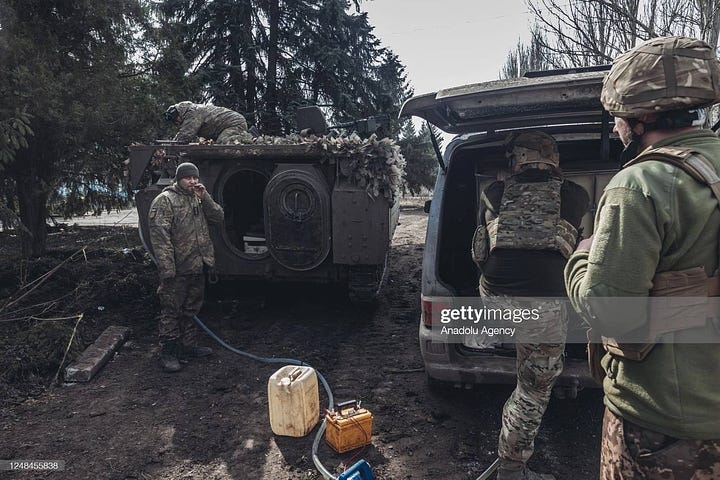

What you see here is how the AFU fuels up its combat vehicles on the frontline. They have these ‘fuel bladders’ inside civilian vehicles, vans, minibuses, etc., which are able to pump the fuel into any piece of armor or APC without being spotted and identified as a fuel truck by Russian drones/ISR, etc. It simply shows the great lengths to which they go, which are beyond what many people are aware of or have envisioned. They most definitely cannot be called un-resourceful or lazy. They are doing all the right things, fighting exactly as they should, and it shows in the length to which they’ve been able to extend this conflict.
But of course, it’s still not enough against Russia. And there have been recent reports specifically revolving around fuel trucks, such that the AFU complains they are running out of proper fuel trucks as Russia is simply destroying them all. A recent spate of videos showing Lancet drones hitting such trucks goes towards legitimizing these worries.
**
A note about Wagner. Another large batch of pardoned ex-convicts have been sent back to society after completing their term. Prigozhin says that 0.31% of them end up as recidivists within a month.
More than five thousand fighters were pardoned after the end of the contract with the Wagner Group. "At the moment, more than five thousand people have completed their contract with PMC Wagner and have been released on a pardon," Prigozhin is quoted as saying in the telegram channel of his press service.
According to him, 0.31% of people committed a second crime within a month, which is 10-20 times less than the standard figures before the special operation.
There were some rumors that Wagner plans to close-up shop after the Bakhmut operation, mostly from fake Western MSM articles. In fact it’s the opposite, there have been Wagner recruitment commercials playing on Russian TV, and recruitment in general is widely expanding:
Recruitment centers for Wagner PMC opened in 42 cities of the Russian Federation - Prigozhin:
“New fighters are coming there, who will go with us side by side to defend their country and their family. To make their common future and protect the memory of the past,” added the head of the Wagner PMC.
Prigozhin says that after the capture of Bakhmut he intends to “reboot" Wagner PMC to turn it from “just a private company, the best in the world” into “an army with an ideology”.
Prigozhin stated they recruit thousands per month but that a large portion of them drop out / fail in the first boot-camp equivalent exercises.
Russia’s Wagner mercenary group plans to recruit approximately 30,000 new fighters by the middle of May, its founder Yevgeny Prigozhin said on Saturday. In an audio Telegram message, Prigozhin said that Wagner recruitment centres, which he said last week had opened in 42 Russian cities, were hiring on average 500 to 800 people a day.
**
A final thing about air defense, and training of the AFU in general.
One report claimed the following:
There is information that the AFU lost almost all Western IRIS-T and NASAMS air defense systems, and there are losses among the trained officer personnel.
This information is partly confirmed by yesterday's statement of the Norwegian Minister of Defense, Bjorn Arild Gram, about the delivery of least two air defense systems, NASAMS, to the Armed Forces of Ukraine because "Ukraine needs additional means of air defense." They will send it together with the United States.In addition, the Norwegians promised to train Ukrainian operators to operate the systems.
John Kirby stated:
The Patriot air defense system will not help Ukraine against Russian cruise missiles, White House Strategic Communications Coordinator John Kirby said.
"The Patriot system is designed to intercept ballistic missiles, it is not as effective against cruise missiles, and it will definitely not be effective against drones," Kirby said in an interview with CNN, adding that it is precisely such weapons that Russian forces often use. He added that the limited capabilities of Ukraine in intercepting hypersonic missiles are not surprising either. "Hypersonic missiles, in general, are very difficult to intercept," Kirby explained.
This is very interesting in light of the fact that just two days ago an American base was hit by cheap Iranian drones, with casualties. U.S. is now scrambling to find out ‘what went wrong’ with their vaunted air defense systems:
They quickly tried to save face with the proven Zelensky method:
The fact of the matter is, time and time again we have seen the American AD fail in every real world encounter. In Saudi Arabia the Patriot system was decimated by Houthi strikes, and had no effect whatsoever in protecting the valuable Saudi oil fields when Houthi strikes wreaked havoc on their oil facilities. From the wiki article on those strikes:
The Abqaiq oil facility was protected by three Skyguard short-range air defense batteries. Neither the Skyguards nor the other Saudi air-defense weapons — MIM-104 Patriot and Shahine (Crotale) — are known to have brought down any of the attacking weapons. A CNBC report offered multiple potential explanations, including that Patriot is optimized for interceping "high-altitude ballistic missiles" and that the Saudi troops operating the defenses "have 'low readiness, low competence, and are largely inattentive.'"




The Crotale mentioned above also happens to be a system already supplied to Ukraine as well.
Meanwhile, spokesman for the AFU, Yuriy Ignat, openly gave his verdict on which Russian systems Ukraine can and can’t shoot down:
The rating of Russian missiles according to the speaker of the Air Force of the Armed Forces of Ukraine Yuriy Ignat, who said that Ukrainian air defense can shoot down and what can not.
Capable:
- "Caliber" (3M14)
- X-101/X-555/X-55 (Kh-101)
- R-500 (9M728)
- X-59 (Kh-59)
- X-35. (Kh-35)Completely Incapable:
- 9M723 - ballistic missile "Iskander-M"
- MLRS rockets, such as "Smerch"
- X-22 - long-range supersonic cruise anti-ship missile
- R-800 - coast-based cruise missile "Onyx"
- X-47 - hypersonic aeroballistic missile "Dagger" (Kh-47 Kinzhal)
- X-31P - aviation anti-radar missile (Kh-31P SEAD missile)
- S-300 anti-aircraft guided missiles.
And lastly, an analysis by Russia’s RYBAR about how the West is training the AFU reprinted in full:
In October, the head of European diplomacy, Josep Borrell, said that by the end of March , more than 11,000 Ukrainian soldiers are planned to be trained at the training grounds of NATO countries. For the whole of 2023, their number may exceed 30 thousand people: the British have already trained 10 thousand people since June 2022, another 15 are planned to be trained in other European countries.
🔻 Main problem
It is difficult to apply the acquired skills on the battlefield: numerous prisoners (including from the elite 45 or 95 Air Assault Brigade) who were trained in NATO countries have repeatedly questioned the effectiveness of training according to Western methods. According to them, at best, the training was superficial and did not guarantee an advantage on the battlefield.
🔻 What's wrong with learning?
Western countries have not been involved in high-intensity conflicts since the Vietnam War, and in some cases since World War II. The result is logical: people are trained according to the patterns of wars in Iraq, Syria and Afghanistan.
🔻Trial and error method
The other side of the problem is the lack of real experience in combat firing from various complexes. For example, the NLAW, Panzerfaust 3 anti-aircraft systems or Gepard anti-aircraft installations before the SMO were used to a limited extent only during the exercises . Now NATO is actively adopting the experience of the SMO for a new training program, but it will take years to implement it.
Yes, Ukrainian formations are fully mastering the entire range of weapons in combat conditions - moreover, in a much shorter time than at Western training grounds. But training is conducted, often, almost by trial and error .
🔻 What about the training base?
For the effective training of Ukrainian formations in the West, there is not enough equipment, weapons and material resources. Prior to the start of the SMO in the West, such simulators were ordered exactly as much as was needed to train the regular number of cadets. At the moment, there are not enough such complexes for everyone.
Shot from machine guns during training abroad often does not exceed two magazines (50-60 rounds), and weapons for this are brought from nearby units.
🔻 What follows from this?
Despite loud statements about the huge number of Ukrainian units trained according to NATO standards, there are problems in the effectiveness of training. Moreover, they accumulate like a snowball, because in the West they rely on training the maximum number of people in a short time. There is no need to talk about the quality of training in such conditions.
From the initial 5-7 weeks, the training program for the infantry formations of the Armed AFU has already been cut to three, and in the case of combined arms units to two.
Probably, by October-November, the number of Ukrainian units trained according to NATO standards will indeed reach 30,000 people.
After returning to the battlefield, soldiers and officers of the AFU face real conditions that are very different from theoretical ones.
And this has all been confirmed and verified by a multitude of AFU prisoners taken recently, including several in the Kremennaya direction who have spoken on this specifically. For instance, this story of AFU troops who trained for a month in the UK and were captured in the first 20 minutes of their very first battle:
A group of Ukrainian soldiers who were trained at a UK military base last summer, surrendered after 20 minutes of the first fighting against Russian forces near Svyatogorsk in the Donetsk People’s Republic, Armed Forces of Ukraine conscript Artyom Kovalenko, a member of the group, told Sputnik.
That’s all for today, we’ll get some on the ground SITREP updates in the next one.





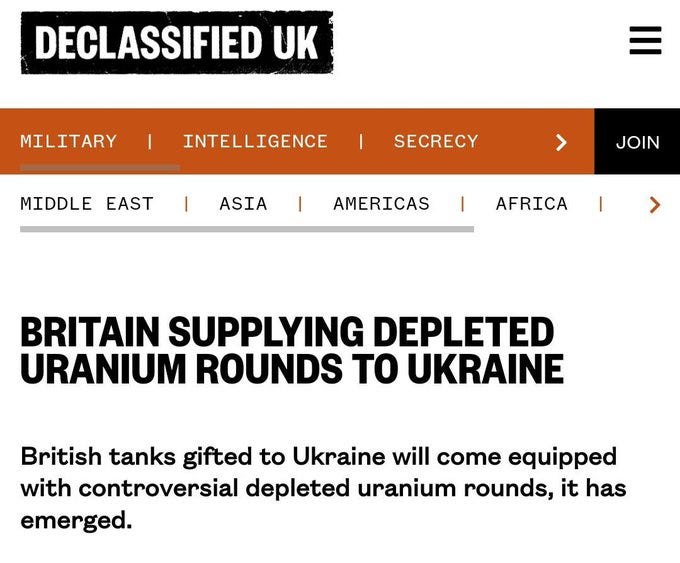
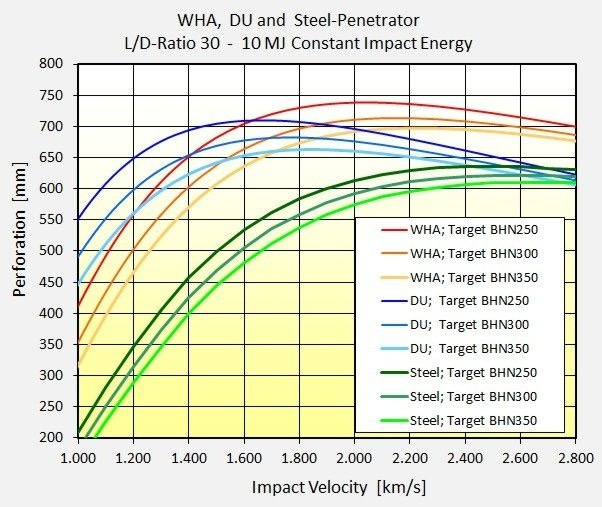

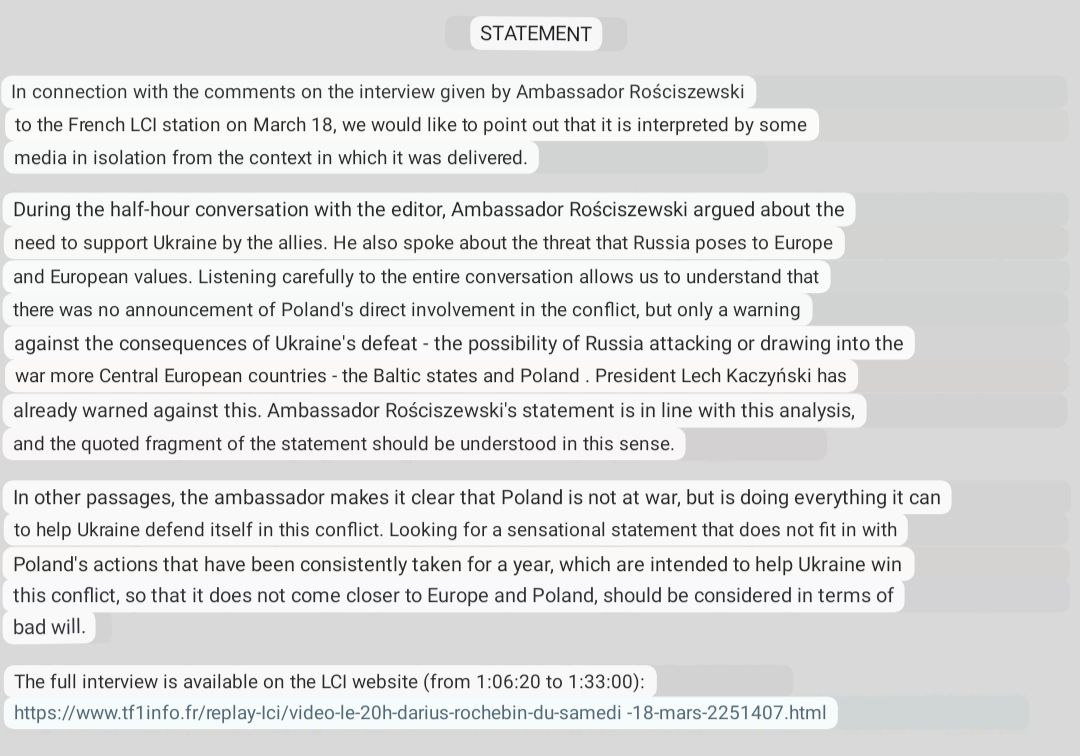
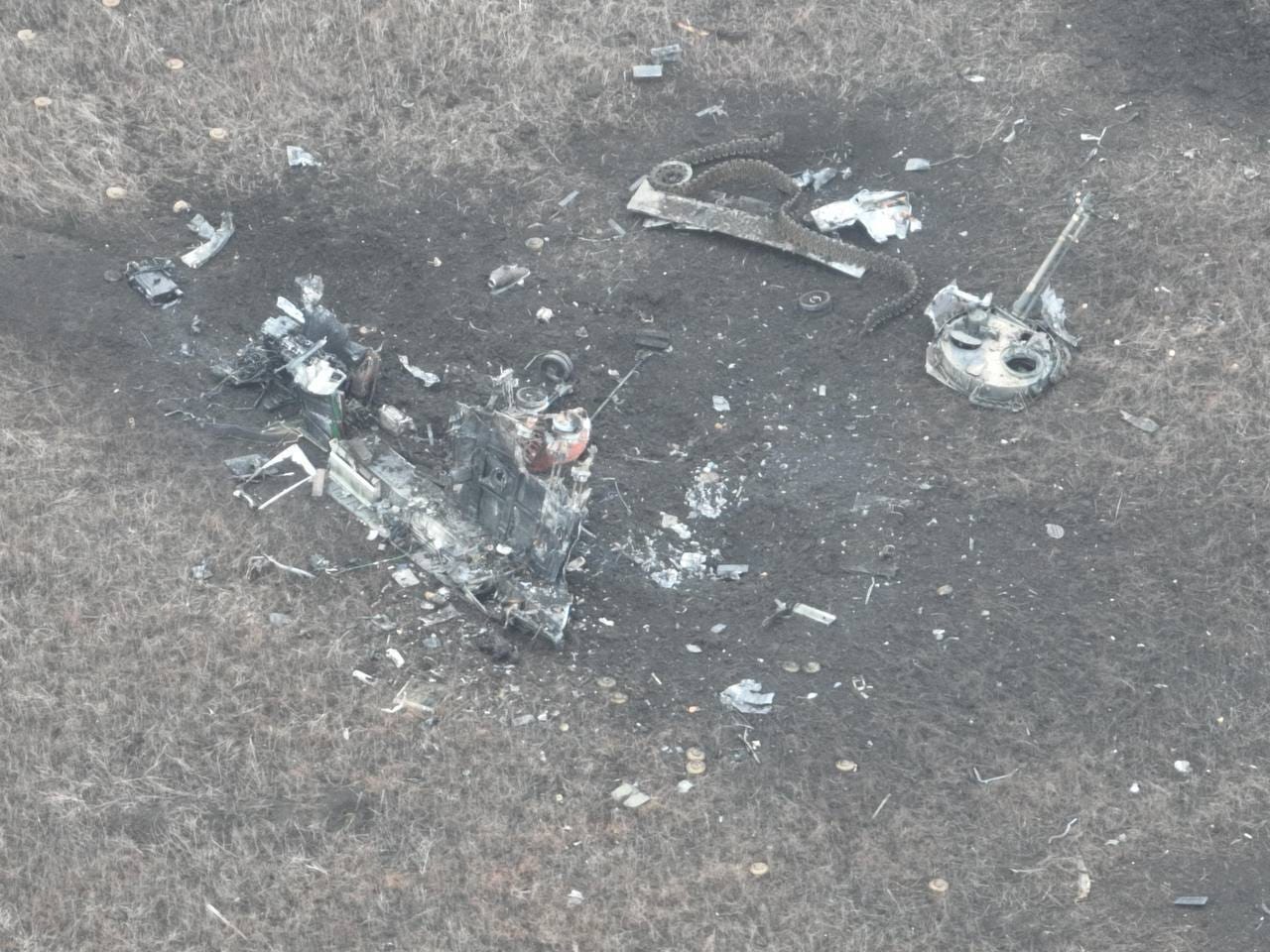

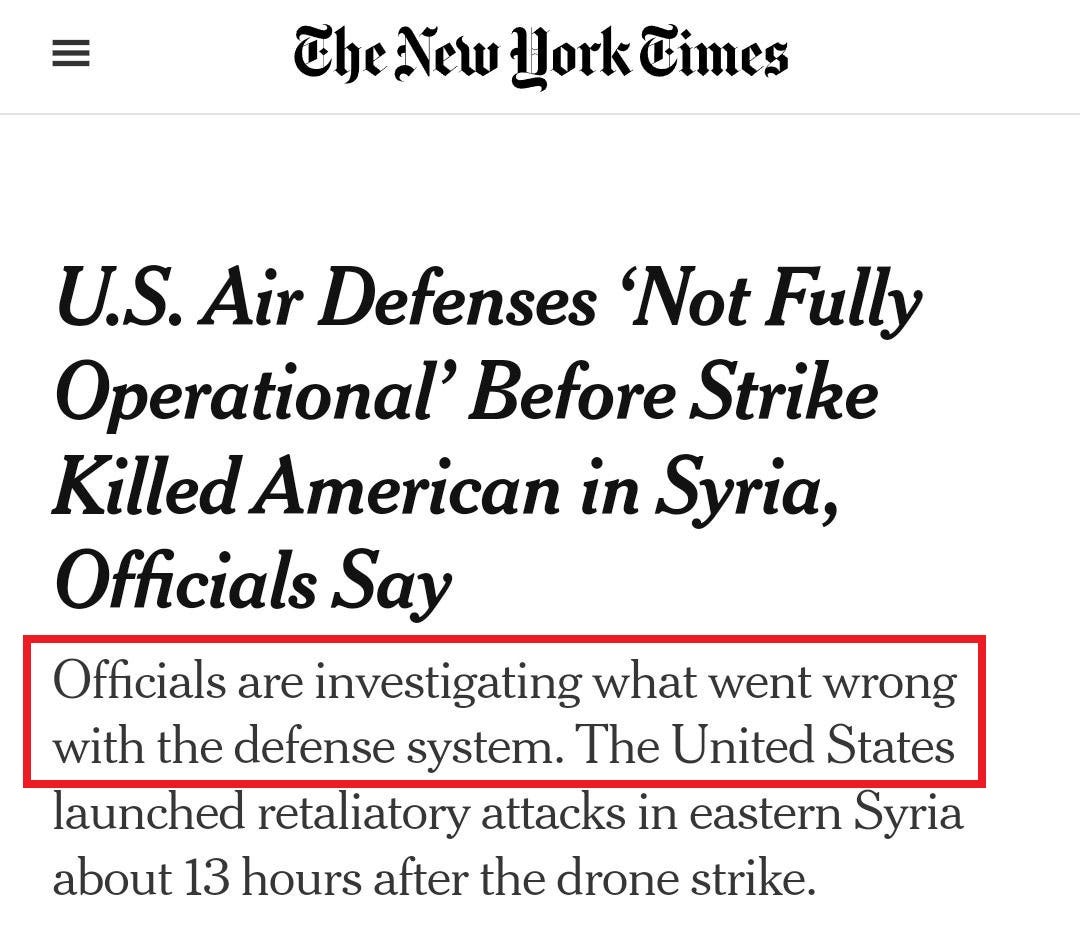
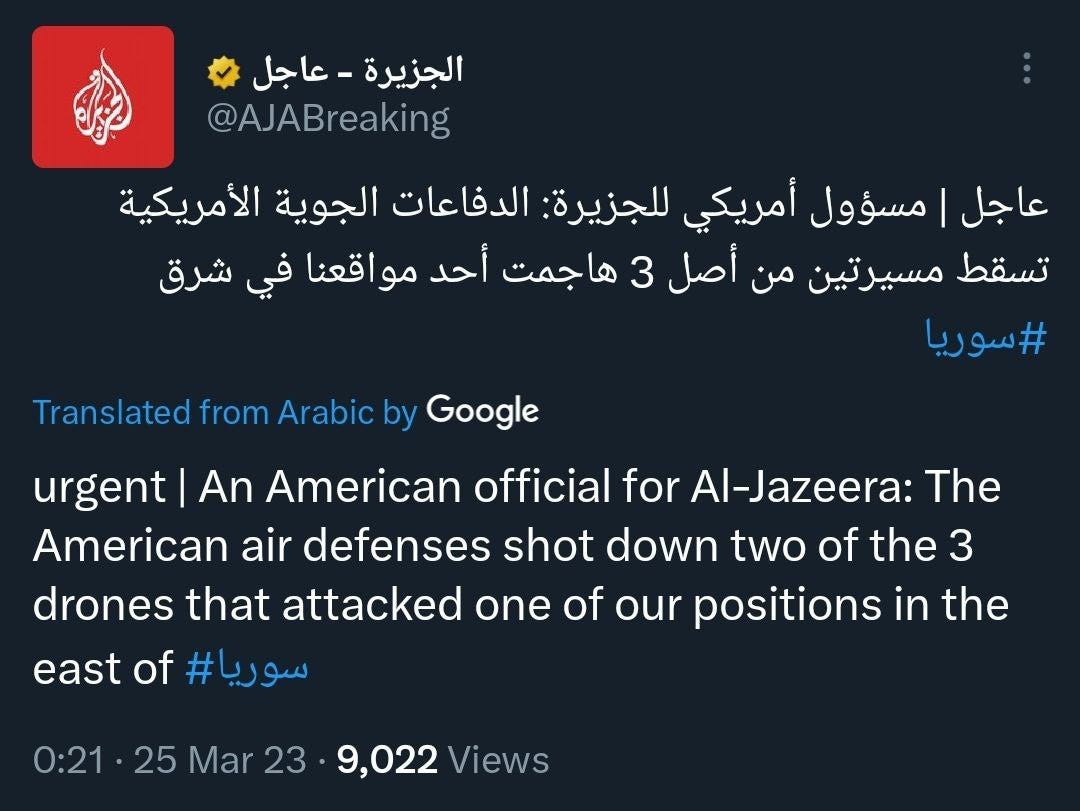

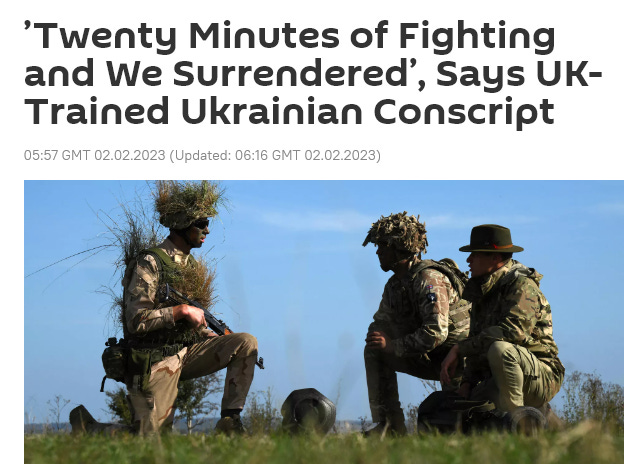
Russia does not need to destroy Dnieper river bridges as things stand today. Most people are very slow to understand Russia is not yet fighting for territory, other than the 4 annexed regions. Russia is also holding back most of its mobilized troops and massive firepower. Russia has a 10 to 1 kill ratio advantage in troops and armaments. It is grinding and pulverizing the Ukraine military while minimizing its own losses. Russia has total conventional and nuclear escalation dominance in Europe, and it has nuclear escalation dominance over the West worldwide. Yes, worldwide. Russian leadership is mature, extremely competent, self-controlled and highly rational. Time is well on their side for at least the next year. NATO leadership is fragile, weak, incompetent and very immature. Russian leadership knew this war was coming in 2007 and perhaps prior. They have prepared. Sure, the West will pull a few more asymmetrical pin-prick attack tricks that will grad ST media headlines, but change nothing. Ukraine will launch its offensives and blow its wad. Russia will destroy the capacity, capabilities, will and spirit of NATO in this war. Success requires nothing short of that. Russia will also control the Black Sea. This is inevitable.
I used to teach an environmental epidemiology course at University of Toronto, and may speak somewhat about the health effects of depleted uranium.
Often the health effects are based on an assumption of their cause. When these rounds were developed, the assumption was that the health effects would be caused by residual radioactivity. But the main isotope in the rounds is U-238 which does not undergo spontaneous fission (hence, undesirable for nuclear reactors) and which has a very long half-life. Consequently, there is minimal health effects caused by the radioactivity.
However, studies from Iraq and Serbia conclusively demonstrated there were serious health consequences from the heavy metal aspect of uranium. In terms of valence and atomic radius, it tends to act like calcium within the body--rather it reports to the same places in the body as calcium would, which is primarily bones (for long-term storage) and the nerves. Unfortunately, once absorbed into the nerves, the uranium displaces calcium, but does not have the functionality of the calcium, i. e., the nerves no longer function properly.
There was evidence as well that uranium accumulates in the genitals (both male and female), where it gets contributed to developing offspring. As such, DU is one of the rare contaminants which, while in the body, can be passed down to the developing next generation. As the fetus grows within the mother's womb, DU that may be stored within the mother's skeleton may be passed to growing fetus, accumulating in bones and nerves.
Worse still, there is some evidence that piezoelectric effects are important in the development of certain structures in the body. Nerves and bones, arteries and veins are all long, thin structures. The piezoelectric effect causes charges to form at the ends of these structures, so that they elongate. Replacing the calcium by uranium reduces this piezoelectric effect so that the structures grow as blocks (nerves, bones, and veins) resulting in the many horrible birth defects observed in areas where DU weapons have been used.
The above information mainly comes from correspondence with a professor of my (slight) acquaintance, who at that time taught at Harvard. He was the real expert on this topic. Unfortunately, I have since lost contact with him.